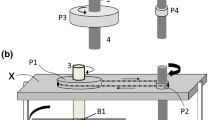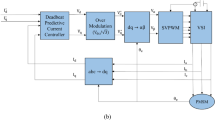Abstract
A balancing method without trial weights based on the dynamic similitude scale model was proposed as a solution to the balancing problem of a large-scale rotor system. This method could be used to directly obtain the required coefficients for the balancing problem of the prototype system through a similarity model test without a prototype test. Thus, the weight test process of the prototype system was effectively eliminated in the proposed balancing method. First, with the rotor system as the research object, the analytical expression of the influence coefficient was derived on the basis of rotor dynamics theory. Then, through calculation and dimensional analysis methods, the similitude relationships of the rotor system and the influence coefficient were deduced on the basis of dynamic similitude theory. The correctness of the proposed similitude relationships was verified through numerical simulation and experiment. The balancing method without trial weights was proposed based on the similitude relationship of the influence coefficient. The effect of the balancing method without trial weights was compared with that of the traditional influence coefficient method through numerical simulation, and the results verified the correctness and effectiveness of the proposed balancing method. The results of this study provide theoretical supplements for the balancing method and the similitude design of the rotor system.
Similar content being viewed by others
References
Foiles W C, Allaire P E, Gunter E J. Review: Rotor balancing. Shock and Vibration, 1998, 5(5–6): 325–336
Zhang S, Zhang Z. Design of an active dynamic balancing head for rotor and its balancing error analysis. Journal of Advanced Mechanical Design Systems & Manufacturing, 2015, 9(1): JAMDSM0001
Han P, Huang S, He G, et al. Experiment based method to evaluate the quality of influential coefficient in rotor dynamic balancing. Journal of Vibration and Shock, 2003, 22(2): 81–85 (in Chinese)
Li X, Zheng L, Liu Z. Balancing of flexible rotors without trial weights based on finite element modal analysis. Journal of Vibration and Control, 2013, 19(3): 461–470
Wang W, Gao J, Jiang Z, et al. Principle and application of no trial weight field balancing for a rotating machinery. Journal of Vibration and Shock, 2010, 29(2): 212–215 (in Chinese)
Bin G, Yao J, Jiang Z, et al. A method of influence coefficient for rotor dynamic balancing based on the finite element model. Journal of Vibration, Measurement & Diagnosis, 2013, 33(6): 998–1002 (in Chinese)
Luo Z, Zhao X, Zhu Y, et al. Determination method of the structure size interval of dynamic similar models for predicting vibration characteristics of the isotropic sandwich plates. Journal of Vibroengineering, 2014, 16(2): 608–622
Coutinho C P, Baptista A J, Dias Rodrigues J. Reduced scale models based on similitude theory: A review up to 2015. Engineering Structures, 2016, 119: 81–94
Zhu Y, Wang Y, Luo Z, et al. Similitude design for the vibration problems of plates and shells: A review. Frontiers of Mechanical Engineering, 2017, 12(2): 253–264
De Rosa S, Franco F, Polito T. Structural similitudes for the dynamic response of plates and assemblies of plates. Mechanical Systems and Signal Processing, 2011, 25(3): 969–980
Zhao J, Wang F, Yu B, et al. Experimental study on the ride comfort of a crawler power chassis scale model based on the similitude theory. Chinese Journal of Mechanical Engineering, 2015, 28(3): 496–503
Wu J. Prediction of lateral vibration characteristics of a full-size rotor-bearing system by using those of its scale models. Finite Elements in Analysis and Design, 2007, 43(10): 803–816
Baxi C B, Telengator A, Razvi J. Rotor scale model tests for power conversion unit of GT-MHR. Nuclear Engineering and Design, 2012, 251(699): 344–348
Hu P. The model experiment analysis of bending vibration of the large rotor system. Mechanical Research Application, 1998, 11(3): 36–38 (in Chinese)
Luo Z, Yan Y, Han Q, et al. Analysis of dynamic similarity of the rotor-bearing system and its effects of bearing parameters. Journal of Vibration and Shock, 2012, 31(Suppl): 12–16 (in Chinese)
Zhong Y, He Y, Wang Z. Rotor Dynamics. Beijing: Tsinghua University Press, 1987, 3–7 (in Chinese)
Kang Y, Lin T W, Chang Y J, et al. Optimal balancing of flexible rotors by minimizing the condition number of influence coefficients. Mechanism and Machine Theory, 2008, 43(7): 891–908
Li Z. Similarity and Modeling. Beijing: National Defense Industry Press, 1982, 27–52 (in Chinese)
Yao M H, Zhang W. Using the extended Melnikov method to study multi-pulse chaotic motions of a rectangular thin plate. International Journal of Dynamics and Control, 2014, 2(3): 365–385
Qin Z Y, Han Q K, Chu F L. Analytical model of bolted disk-drum joints and its application to dynamic analysis of jointed rotor. Proceedings of the Institution of Mechanical Engineers, Part C: Journal of Mechanical Engineering Science, 2014, 228(4): 646–663
Zhang D, Fu J, Zhang Q, et al. An effective numerical method for calculating nonlinear dynamics of structures with dry friction: Application to predict the vibration response of blades with underplatform dampers. Nonlinear Dynamics, 2017, 88(1): 223–237
Jalan A K, Mohanty A R. Model based fault diagnosis of a rotorbearing system for misalignment and unbalance under steady-state condition. Journal of Sound and Vibration, 2009, 327(3–5): 604–622
Yang X D, Zhang W. Nonlinear dynamics of axially moving beam with coupled longitudinal-transversal vibrations. Nonlinear Dynamics, 2014, 78(4): 2547–2556
Acknowledgements
This work was supported by the National Natural Science Foundation of China (Grant No. 11572082), the Excellent Talents Support Program in Institutions of Higher Learning in Liaoning Province of China (Grant No. LJQ2015038), and the Fundamental Research Funds for the Central Universities of China (Grant Nos. N160312001, N150304004, and N140301001).
Author information
Authors and Affiliations
Corresponding author
Rights and permissions
About this article
Cite this article
Ye, R., Wang, L., Hou, X. et al. Balancing method without trial weights for rotor systems based on similitude scale model. Front. Mech. Eng. 13, 571–580 (2018). https://doi.org/10.1007/s11465-018-0478-x
Received:
Accepted:
Published:
Issue Date:
DOI: https://doi.org/10.1007/s11465-018-0478-x




